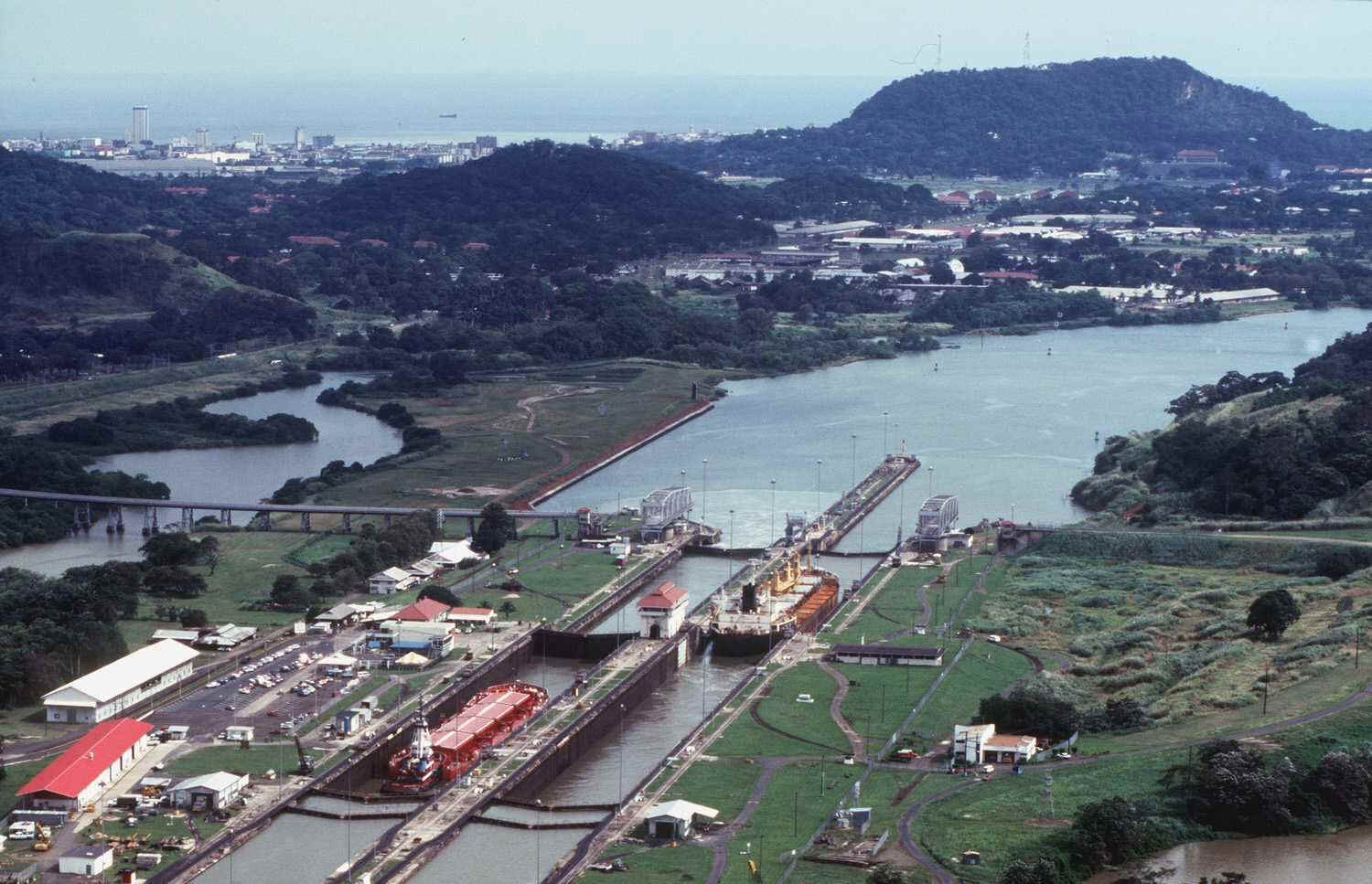PURPOSE OF THE
TREATIES
In negotiating these treaties, the
United States proceeded on the assumption that they would serve
the national interest by ensuring that the canal would continue to
be efficiently operated, secure, neutral, and open to all nations
on a nondiscriminatory basis. Fundamental to this objective was
the cooperation of Panama. By responding to Panamanian
aspirations, the United States intended to provide a more
satisfactory environment for the operation and defense of the
canal.
The new treaties provided a basis
for a new partnership between the United States and Panama. They
replaced the U.S.-Panama Treaty of 1903 (known as the Hay/Bunau-Varilla
Treaty), which governed canal operations since the waterway's
construction (completed and opened to world commerce in 1914) and
subsequent revisions to it by the treaties of 1936 and 1955 which
modified some of its terms.

Miraflores
Locks of the Panama Canal -- Panama City is in the
left far background and Ancon Hill in the right
background. [Photo courtesy of the Panama Canal
Commission/Panama Canal Authority; used with permission.] |
HISTORY OF
TREATY NEGOTIATIONS
Panamanian foreign policy focused
on the Panama Canal virtually since its completion in 1914.
In November 1903, the United States
and the Republic of Panama signed a treaty for the canal
concession fifteen days after Panama had declared her independence
from Colombia on November 3, and the United States promptly
recognized the new nation.
The treaty (negotiated on behalf of
the new nation -- but not necessarily with in its best interests
in mind -- by the Frenchman Philippe Burnau-Varilla) gave the
United States not only the right to build a canal but also the
rights, power, and authority to exercise to exercise jurisdiction,
"as it sovereign, in perpetuity" over a 10-mile strip
across the isthmus of Panama to be known as the Canal Zone (647
square miles total area, of which land area was 372 square miles
and water area was 275 square miles). Bunau-Varilla was mostly
determined to try to recoup for France at least some of the glory
lost in the decade-long ill-fated French effort to construct a
sea-level canal through Panama in the 1880s. With history in mind,
he manipulated concessions for the treaty which he felt would
ensure acceptance by the United States Government, shortly after a
similar treaty with less generous terms had been proposed by the
United States and rejected by the Colombian senate.
The 1903 treaty -- which was not
signed by a Panamanian -- was deeply resented by Panamanians
virtually since its inception and had periodically impacted
negatively on Panama-United States relations over the years.
Negotiations for a new treaty had been a long-standing Panamanian
priority. Such feelings, came to a head on January 9, 1964,
outside the Balboa High School in the Canal Zone when Panamanian
dissatisfaction sparked by an unsuccessful protest by Panamanian
students after requesting to fly the Panamanian flag in front of
the school where only one flag pole was located, shortly erupted
into violence followed later by riots in Panama City and the city
of Colon. During the violence, 21 Panamanians and four U.S.
military personnel died. A few days later, Panama suspended
diplomatic relations with the United States. (For detailed Panama
Canal Spillway's account, visit the following site: www.czbrats.com/Articles/Flag_pole.htm.)
After relations were reestablished in
April 1964, the two governments agreed to appoint ambassadors with
sufficient powers to seek a prompt resolution of the conflict.
Negotiations began shortly thereafter.
In June 1967, United States and
Panamanian representatives completed the negotiation of three
draft treaties dealing with the canal, a possible sea-level canal
in Panama, and defense matters. Neither government acted further
on these treaties, however, and in a new Panamanian government
(established after the 1968 coup by the Panamanian National Guard)
publicly rejected the proposed treaties.
Canal treaty negotiations resumed
in June 1971 and continued intermittently. In February 1974, U.S.
Secretary of State Henry Kissinger and Panamanian Foreign Minister
Tack signed in Panama an "eight-point principles"
agreement which served as guidelines for further negotiations.
Several preliminary agreements were initialed in late 1974 and
early 1975, and the negotiations continued through 1975 and 1976.
They were finally concluded in 1977 after intense and-and-off
negotiations and signed on September 7, 1977.
In accordance with their
constitution, the Panamanian people approved the new treaties by a
two-thirds majority in a plebiscite held on October 23, 1977. The
U.S. Senate gave its consent to the ratification of the neutrality
treaty on March 16, 1978, and the Panama Canal Treaty on April 18,
1978, both barely by a two-thirds majority. The U.S. Senate's
conditions, reservations, and understandings attached to the two
treaties (which were later embodied in the "Protocol of
Exchange of Instruments of Ratification of the Panama Canal
Treaties") were accepted begrudgingly by General Torrijos who
decided he need not present the changes to another plebiscite.